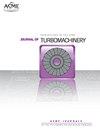利用热成像荧光粉对模拟发动机条件下的气膜冷却叶片进行热评估的新策略
IF 3.1
3区 工程技术
Q3 ENGINEERING, MECHANICAL
引用次数: 0
摘要
薄膜冷却叶片热评估的实用策略对燃气轮机界具有重要意义。由于物理或方法的限制,很难在模拟发动机条件下评估叶片的热性能。本研究提出了一种用于叶片冷却检测的新型基于聚焦扫描的磷光体测温方法。当Mg4FGeO6:Mn(MFG)作为温度传感器来量化叶片温度并模拟TBC效应时,采用了焦扫描方法来克服级联测试中的光学约束。所获得的微观结构、射流冲击和抗侵蚀试验的MFG结果表明,MFG磷光体足够坚固,可以模拟TBC的隔热效果,并且可以承受高速流动侵蚀。此外,所提出的策略以高空间分辨率清晰地捕捉到了叶片温度分布(T_(0.8)=~850K时的主流),然后成功地将其重新映射到三维扭曲叶片上。与热电偶的额外比较表明,模拟的TBC具有约68K的隔热效果。本研究解决了叶片冷却评估中磷光体测温的常见问题,为燃气轮机未来的热诊断提供了一种实用的策略。本文章由计算机程序翻译,如有差异,请以英文原文为准。
Novel strategy for thermal evaluation of film-cooled blades using thermographic phosphors at simulated engine conditions
Practical strategy for the thermal evaluation of film-cooled blade is of great importance to the gas turbine community. Due to the physical or methodology limitations, it is difficult to evaluate the blade's thermal performance at simulated engine conditions. The present study proposed novel focal-sweep-based phosphor thermometry for blade cooling inspection. While Mg4FGeO6:Mn (MFG) served as the temperature sensor to quantify the blade temperatures as well as simulated the TBC effect, the focal sweep method was adopted to overcome the optical constraints in cascade testing. The obtained MFG results of microstructures, jet impingement, and anti-erosion test demonstrated that the MFG phosphor is robust enough to simulate the thermal insulation effect of TBC and can withstand high-speed flow erosion. Furthermore, the proposed strategy clearly captured the blade temperature distributions (mainstream at T_(0,8)=~850 K) with high spatial resolution, which was then successfully remapped onto the three-dimensional twisted blade. Additional comparisons with the thermocouples demonstrated that the simulated-TBC has a thermal insulation effect of about 68K. This study addressed the common problems of phosphor thermometry in blade cooling evaluation, offering a practical strategy for future thermal diagnostics of the gas turbine.
求助全文
通过发布文献求助,成功后即可免费获取论文全文。
去求助
来源期刊
CiteScore
4.70
自引率
11.80%
发文量
168
审稿时长
9 months
期刊介绍:
The Journal of Turbomachinery publishes archival-quality, peer-reviewed technical papers that advance the state-of-the-art of turbomachinery technology related to gas turbine engines. The broad scope of the subject matter includes the fluid dynamics, heat transfer, and aeromechanics technology associated with the design, analysis, modeling, testing, and performance of turbomachinery. Emphasis is placed on gas-path technologies associated with axial compressors, centrifugal compressors, and turbines.
Topics: Aerodynamic design, analysis, and test of compressor and turbine blading; Compressor stall, surge, and operability issues; Heat transfer phenomena and film cooling design, analysis, and testing in turbines; Aeromechanical instabilities; Computational fluid dynamics (CFD) applied to turbomachinery, boundary layer development, measurement techniques, and cavity and leaking flows.

 求助内容:
求助内容: 应助结果提醒方式:
应助结果提醒方式:


